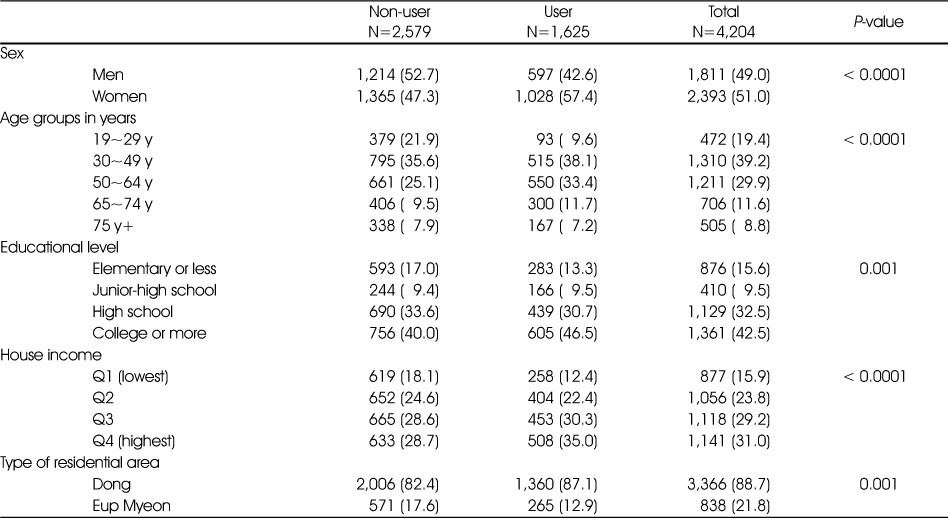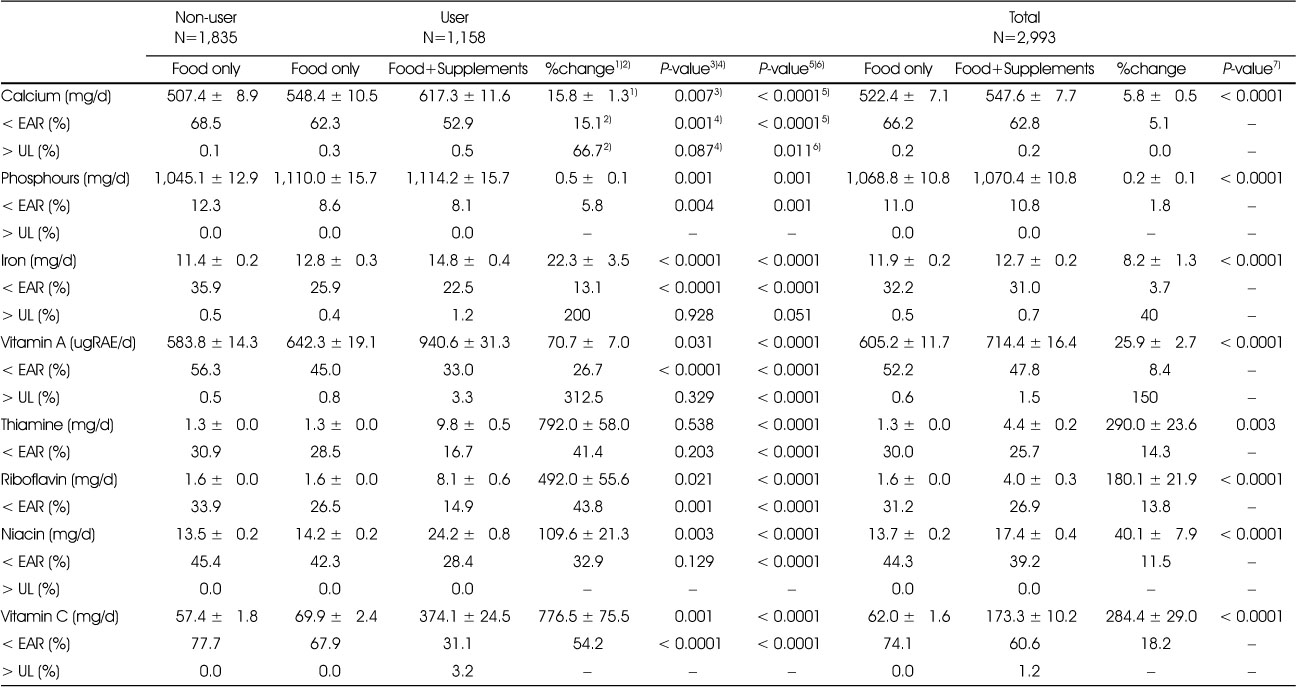Articles
- Page Path
- HOME > Korean J Community Nutr > Volume 25(4); 2020 > Article
- Research Article
- Evaluation of Nutritional Status of Vitamins and Minerals According to Consumption of Dietary Supplements in Korean Adults and the Elderly: Report Based on 2017 Korea National Health and Nutrition Examination Survey data
- Ji-Myung Kim
-
Korean Journal of Community Nutrition 2020;25(4):329-339.
DOI: https://doi.org/10.5720/kjcn.2020.25.4.329
Published online: August 31, 2020

-
Corresponding author:
Ji-Myung Kim,
Email: kjm@shinhan.ac.kr
- 1,147 Views
- 9 Download
- 5 Crossref
- 0 Scopus
Abstract
Objective
This study was undertaken to evaluate the intake of vitamins and minerals from dietary supplements (DSs) in Korean adults and elderly.
Methods
Data for this study was generated from the 2017 Korea National Health and Nutrition Examination Survey (KNHANES). We analyzed 4,204 individuals aged 19 years and older (2,579 users and 1,625 non-users). The survey included 24-h recall questions on food and DS intakes, as well as questions on DS use over the past year. The nutrient DSs evaluated were calcium, phosphorus, iron, vitamin A, thiamin, riboflavin, niacin, and vitamin C. Total nutrient intakes were obtained by combining nutrient intakes of foods and DSs consumed by each subject.
Results
Most micronutrient intakes from food (except for thiamin) in adult users, and the four micronutrient intakes (iron, vitamin A, vitamin B2 and vitamin C) in elderly users, were significantly higher than values obtained in non-users. For total intake of nutrients and DSs, both adult and elderly users had a significantly higher intake than non-users. While proportions below Estimated Average Requirements for all micronutrients by adding respective DSs in users were significantly reduced in adults and elderly as compared to non-users, the proportions of above Tolerable Upper Intake Levels for calcium and vitamin A in adults, and vitamin A in elderly, were significantly increased. In the total subjects examined, consumption of DSs was associated with lower odds ratios of undernutrition of micronutrients, and with higher odds ratios of overnutrition of calcium, iron, and vitamin A, as compared to non-users of DSs.
Conclusions
Although DSs consumption by adults and the elderly improves the micronutrient status, it also increases the risk of excessive intake of certain vitamins and minerals.
Published online Aug 31, 2020.
https://doi.org/10.5720/kjcn.2020.25.4.329
Evaluation of Nutritional Status of Vitamins and Minerals According to Consumption of Dietary Supplements in Korean Adults and the Elderly: Report Based on 2017 Korea National Health and Nutrition Examination Survey data
Abstract
Objectives
This study was undertaken to evaluate the intake of vitamins and minerals from dietary supplements (DSs) in Korean adults and elderly.
Methods
Data for this study was generated from the 2017 Korea National Health and Nutrition Examination Survey (KNHANES). We analyzed 4,204 individuals aged 19 years and older (2,579 users and 1,625 non-users). The survey included 24-h recall questions on food and DS intakes, as well as questions on DS use over the past year. The nutrient DSs evaluated were calcium, phosphorus, iron, vitamin A, thiamin, riboflavin, niacin, and vitamin C. Total nutrient intakes were obtained by combining nutrient intakes of foods and DSs consumed by each subject.
Results
Most micronutrient intakes from food (except for thiamin) in adult users, and the four micronutrient intakes (iron, vitamin A, vitamin B2 and vitamin C) in elderly users, were significantly higher than values obtained in non-users. For total intake of nutrients and DSs, both adult and elderly users had a significantly higher intake than non-users. While proportions below Estimated Average Requirements for all micronutrients by adding respective DSs in users were significantly reduced in adults and elderly as compared to non-users, the proportions of above Tolerable Upper Intake Levels for calcium and vitamin A in adults, and vitamin A in elderly, were significantly increased. In the total subjects examined, consumption of DSs was associated with lower odds ratios of undernutrition of micronutrients, and with higher odds ratios of overnutrition of calcium, iron, and vitamin A, as compared to non-users of DSs.
Conclusions
Although DSs consumption by adults and the elderly improves the micronutrient status, it also increases the risk of excessive intake of certain vitamins and minerals.
Table 1
General characteristics of dietary supplement users and non-user among Korean
Table 2
Comparison of nutrient intakes from diet and total nutrient intakes from diet and supplements between non users and users in adults
Table 3
Comparison of nutrient intakes from diet and total nutrient intakes from diet and supplements between non users and users in elderly
Table 4
Odds ratio of insufficient and excessive nutrient intakes according to use of dietary supplements
References
-
Ministry of Food and Drug Safety. Functional food [internet]. Ministry of Food and Drug Safety; 2020 [cited 2020 Aug 20].Available from: http://www.foodsafetykorea.go.kr/.
-
-
Ministry of Food and Drug Safety. 2018 Food and Drug Statistical Yearbook. Cheongju: Ministry of Food and Drug Safety; 2018.
-
-
Ministry of Health and Welfare (KR), Korea Center for Disease Control and Prevention. Korea Health Statistics 2017: Korea National Health and Nutrition Examination Survey (KNHANES VII-2). Cheongju: Korea Center for Disease Control and Prevention; 2018.
-
-
Yoo YJ, Hong WS, Choi YS. The experience of nutrient supplement use among adults in the Seoul area. J Korean Soc Food Nutr 2001;30(2):357–363.
-
-
Kim SY, You JS, Chang KJ. Consumption of health functional food and dietary habits, nutrient intake and dietary quality of college students in Incheon. J Nutr Health 2013;46(2):166–176.
-
-
Lee YO, Song Y. Sociodemographic characteristics, lifestyle factors, and nutrient intake by taking vitamin/mineral supplements. Korean J Food Culture 2010;25(4):480–486.
-
-
Kim YJ, Mun JA, Min HS. Supplement dose and health-related life style of vitamin-mineral supplement user among Korean middle-aged. Korean J Community Nutr 2004;9(3):303–314.
-
-
Lee HS, Han JH, Kim SH. Prevalence of vitamin · mineral supplement use and its related factors among Korean adolescents. J Nutr Health 2013;46(6):552–559.
-
-
Yoon L, Yang J, Kweon S, Oh K. Dietary supplement intake based on the Korea national health and nutrition examination survey in 2015. Public Health Wkly Rep 2018;11(7):188–192.
-
-
Willett W. In: Nutritional epidemiology. 3rd ed. Oxford: Oxford University Press; 2013.
-
-
Lee YJ, Kang M, Paik HY, Song YJ. Use of dietary supplements and determinants of taking dietary supplements by gender in the Korean population: using the 4th Korean National Health and Nutrition Examination Survey (2007–2009). Korean J Community Nutr 2017;22(4):347–355.
-
-
Dickinson A, Mackay D. Health habits and other characteristics of dietary supplement users: a review. Nutr J 2014;13(1):14–21.
-
-
Lee HH, Park HA, Kang JH, Kang JH, Kim KW, Cho YG. What types of dietary supplements are used in Korea? Data from the Korean National Health and Nutritional Examination Survey 2005. Korean J Fam Med 2009;30(12):934–943.
-
-
Joo NS, Dawson-Hughes B, Kim YS, Oh K, Yeum KJ. Impact of calcium and vitamin D insufficiencies on serum parathyroid hormone and bone mineral density: analysis of the fourth and fifth Korea National Health and Nutrition Examination Survey (KNHANES IV-3, 2009 and KNHANES V-1, 2010). J Bone Miner Res 2013;28(4):764–770.
-
-
Ministry of Health and Welfare, The Korean Nutrition Society, Dietary reference intakes for Koreans 2015. Sejong: Ministry of Health and Welfare; 2015.
-
- Related articles
-
- Trends in growth and nutritional status of Korean toddlers and preschoolers: a cross-sectional study using 2010–2021 Korea National Health and Nutrition Examination Survey data
- Biochemical characteristics, nutrient intakes, and chronic disease risk according to the dietary fat energy ratio in middle-aged Korean: a cross-sectional study using data from the 7th (2016–2018) Korean National Health and Nutrition Examination Survey
- Total sugar intake and its contributed foods by age groups in Koreans using the 8th (2019–2021) Korea National Health and Nutrition Examination Survey: a cross-sectional study
- Estimating and evaluating usual total fat and fatty acid intake in the Korean population using data from the 2019–2021 Korea National Health and Nutrition Examination Surveys: a cross-sectional study
- Comparative study on the health and dietary habits of Korean male and female adults before and after the coronavirus disease 2019 pandemic: utilizing data from the 8 th Korea National Health and Nutrition Examination Survey (2019–2021)

 KSCN
KSCN





 Cite
Cite


